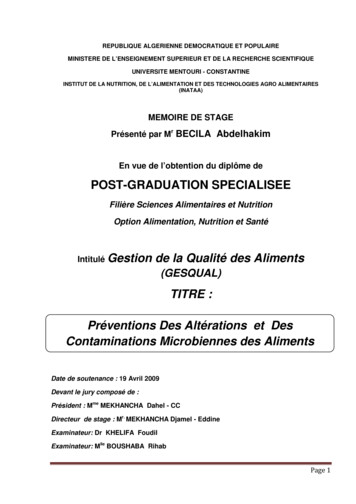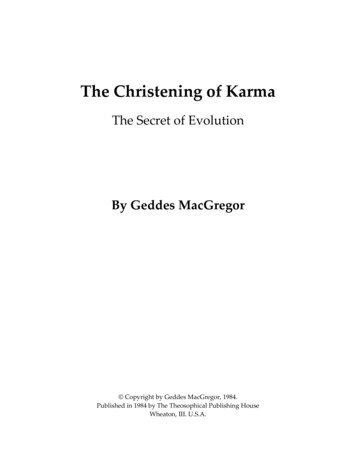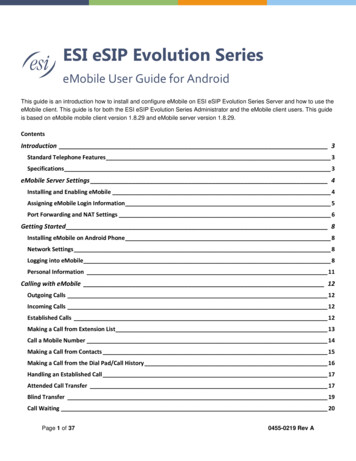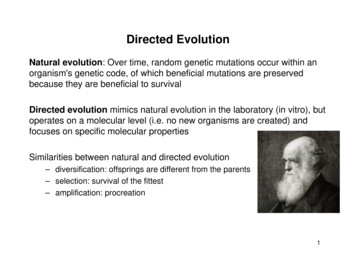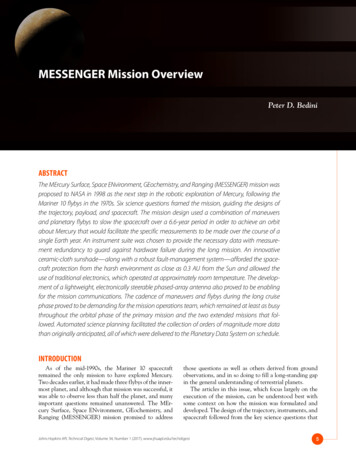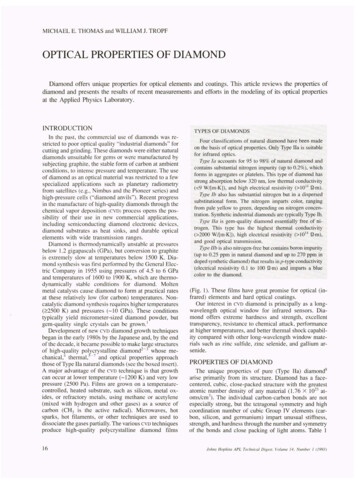
Transcription
The Evolution of Strategyin the Global War on Terrorprepared byLTC(R) Robert R. LeonhardThe Johns Hopkins UniversityApplied Physics Laboratoryi
This paper and its ideas are intended to stimulate and provoke serious thinking.Not everyone will agree with them. Therefore it should be noted that thisreport reflects the views of the author alone and does not necessarily implyconcurrence by the Johns Hopkins University Applied Physics Laboratory(JHU/APL) or any other organization or agency, public or private.ii
About the AuthorLTC(R) Robert R. Leonhard is on the senior staff of The Johns Hopkins UniversityApplied Physics Laboratory and is a member of the Strategic Assessments Office ofthe National Security Analysis Department. He retired from a 24-year career in theArmy, serving as an infantry officer and war planner, and he is a veteran of OperationDesert Storm. He is the author of The Art of Maneuver: Maneuver Warfare Theoryand AirLand Battle (1991), Fighting by Minutes:Time and the Art of War (1994), and ThePrinciples of War for the Information Age (1998), as well as numerous articles and essayson national security issues.iii
iv
I won a game of chess yesterday. I used my favorite white strategy, theStonewall Attack, and the black player succumbed to my bishop sacrificeas planned. By twelve moves into the game, it was all over.Although we sometimes use chess as an analogy for describing warfare,real war strategy is much harder to grasp than chess strategy. It is quitecommon for a chess player to conceive his strategy before the firstmove (indeed, one can hardly be considered an accomplished player if hisopening moves are not informed by some specific strategy) and for thatstrategy to prevail throughout the game. But in war—especially in a longwar—the strategy one begins with will most likely evolve over time intoan altogether different (sometimes even opposite) strategy than the onebegan with. Strategic formulation in chess is a matter of education in thegame and the individual player’s preferences. It is unconstrained by otherfactors. But strategic formulation in war is constrained and influenced bypolitical, social, and economic factors that are constantly in flux. Oftenthose factors conspire to produce bad strategy that fails—sometimes in alimited way, sometimes catastrophically. If a nation can survive the failures,it can then graduate to the grasp of a winning strategy.The purpose of this essay is to illustrate from the history of our Civil Warhow strategy evolves and then to extrapolate and suggest ways in whichstrategy in the global war on terror will likely evolve. I have organizedthe essay into two major parts: the introduction of the subject and thenan after-action report on a conference sponsored by The Johns HopkinsUniversity Applied Physics Laboratory. The goal is to show which aspectsof the American strategy in the war on terror will probably change andthen to suggest how they will change. I will also include some specificpolicy recommendations, most of which emanate from conference results.v
vi
1. INTRODUCTIONIn 1861, President Abraham Lincoln had to derive astrategy for winning the Civil War. He and his warcabinet chose a strategy that was almost 100% offthe mark. It led to failure after failure until threeyears later, by which time the strategy changed intoan utterly different, war-winning plan.was this erroneous assessment that led to the FirstBattle of Manassas—and the Union’s first failure.The first, but by no means the last. Stalemateand failure followed on the Peninsula. Thenfailure at Second Manassas. Then stalemate atAntietam, disaster at Fredericksburg, and defeat atChancellorsville. By the time of the Union victoriesatVicksburg and Gettysburg, both Lincoln and Grantwere beginning to get a much clearer understandingof the true nature of the war and what would haveto be done to win it. After Antietam, Lincoln, whodid not even want to touch the slavery issue at first,emancipated the slaves—a radical step to take thatwould ipso facto turn the “secession crisis” into afull-scale total war. The president’s more realisticunderstanding of the situation found expression inhis ominous words at Gettysburg—“Now we areengaged in a great civil war .” Later, he jettisonedthe cultural sensitivities that had prevented roughtreatment of Confederates and their property andinstead substituted a policy of deliberate destructionof the South’s economic base.How did the Union finally prevail in 1864–65? Whatwere the components of their strategy that resultedin the defeat of the Confederacy? Conscript, deploy, and attacksimultaneously with multiple large armiesagainst critical points in the Confederacy. Suspend civil liberties when and wherenecessary. Interdict the Mississippi Valley from Cairoto New Orleans. Seize or blockade the Gulf and Atlanticports. Confiscate and/or destroy property. Destroy infrastructure in the ShenandoahValley and throughout the South.Experimentation and failure had informed anddisciplined the Union’s strategic formulation untilthey gave birth to a war-winning strategy. In thesame way, America and her allies must expect toevolve a strategy for the global war on terror—astrategy likely to be quite different from the onewe began with. If the American Civil War patternholds, the components of our eventual war-winningstrategy may be too politically or culturally sensitiveto consider right now. As occurred in the 1860s, wewill have to soak up more failures and stalematesbefore we can learn the right strategy. Furtherattacks on the scale of 9/11 might well propel usalong that path, just as bloody Fredericksburg andChancellorsville served to educate Union strategists.Historically it has always been difficult for a nationto think critically about the evolution of strategyuntil it is forced to do so through failure. Emancipate the slaves to close off anypossibility of a Confederate alliance withGreat Britain and to disable the Southerneconomy.These critical components of the 1864–65 Unionstrategy were effective in ending the bloodiestwar in American history, but they were not thestrategy of choice in 1861. In fact, Lincoln and hiscabinet could scarcely even discuss these options.The political, social, and economic context of theearly war disallowed any consideration of suchdrastic measures. When Sherman predicted thatthe war would be long and exceedingly bloody, hewas dismissed as insane. Even the nature of thewar itself was at first unclear. Lincoln consideredit a “secession crisis” caused by a few malcontents,while the rest of the South desired reconciliation. It1
But we could perhaps identify at least the majoraspects of our strategy that are most likely toevolve. In Lincoln’s case, the critical componentsthat changed over time werethere and neutralize it. Four years after the initialcrisis, American strategy continues to focus on thecapture of individuals as a key measure of success,but there is increasing evidence that the networkis not so centralized as once believed. The list ofwanted individuals grows, while the likely effectsof individual captures diminishes. Although it iscertainly reasonable to continue to pursue knownorganizers, it is becoming obvious that the problemtranscends mere criminality and the influence of afew malcontents. Determination of the nature of the enemyand the war Means and methods for defeating theenemy Required force structure for defeating theenemy The slavery issueThe decision to name the effort the “war on terror”was intended to cater to the cultural and politicalsensitivities of Muslims. In 2001 it was not politicallyacceptable to suggest that the terror problememanated from serious and long-lived problemswithin the Islamic world. Such a conclusion wouldsmack of religious bigotry and might inflameMuslims, thus worsening the insurgency problem.Instead, the Administration focused not on theenemy but rather on the enemy’s weapon ofchoice: terror. Many commentators today think thischoice regrettable and somewhat ridiculous. It isanalogous to declaring a war on knives or a war onsubmarines. Identification of the right militaryleadershipIn the war on terror, there are at least three obviouspoints—critical components of our strategy—thathave attracted controversy and that are likely tochange over time. Some of these components aresimilar to those confronting Lincoln: Determination of the nature of the enemyand of the war Definition of success Means and methods for defeating theenemyThe Nature of the EnemyFocusing on a tactic is not unprecedented, however.Our wars in the Mediterranean in the late 18th andearly 19th centuries were aimed at the eradicationof piracy—a tactic employed by various Barbarypowers at the time. Still, the present “war on terror”seems to miss the point that, as one commentatorput it, “not all Muslims are terrorists, but allterrorists are Muslims.” The observation, of course,is exaggerated to the level of being untrue, but thepoint remains: the global war on terror is aimedat Islamic terrorists, not terror in general. Further,terror played a prominent role in the creation ofour own republic. New Englanders destroyed thehouse of Governor Thomas Hutchinson in orderto terrorize him and his fellow governors. Burningsin effigy, inflammatory editorials, and the occasionaltar-and-feathering were all well known factors inour drive for independence.Shortly after 9/11, the Bush Administration began tocharacterize the enemy as a network of criminalsand terrorists who enjoyed the protection of theTaliban in Afghanistan but who commanded littlesympathy among the vast majority of Muslimsworldwide. This handful of miscreants had anexceptional bent for nihilism and were diabolicallytalented troublemakers, but they were in no wayrepresentative of Islamic culture as a whole.The implications of this theory were profound. Ifthe enemy indeed consisted of a small group ofprofessional criminals, then defeating them was arelatively simple matter of finding the bad guys andkilling or capturing them. Preliminary to that step,the Administration decided to remove the Talibanregime in order to expose the terrorist network2
If we are honest with our own past, we wouldconclude that the problem is not terror or eventerrorists, but rather the purposes that the terrorserves. In our current war, the problem is a globalsystem of Islamic insurgencies. Those insurgenciesaim at destroying current Islamic regimes in theMiddle East and elsewhere, and incidentally aim atthe West, which is perceived as propping up corruptregimes as well as supporting Israel.with Middle Eastern dictatorships, pointing to thefact that both appeal to Islamic ideology, and bothcall for totalitarianism. Both, in short, are fascist.Others have pointed not to Islam, but to thetangential issue of the Middle East itself. Thealmost universal failure in both economics andpolitics throughout the region has left a burgeoningpopulation of discontented, unemployed, angryyoung men, whose proclivity for violence has littleto do with religion. If this interpretation is correct,then strategies aimed at neutralizing professionalcriminals or causing a Muslim reformation areworse than irrelevant. In this case, the answers havelittle to do with military solutions and a lot to dowith nation-building and economic investment.As the war and its strategies continue to evolve,it is likely that America and her allies will begin todefine the enemy in broader, systematic, and culturalterms. Some commentators, for example, take onthe underlying theory of the current strategy byquestioning the existence and relevance of so-called“moderate” Islam. Initial hopes were that with theelimination or marginalization of the violent Islamicradicals, the large, silent majority of peace-loving,democracy-wanting, non-violent Muslim moderateswould emerge. Islamic Thomas Jeffersons and JamesMadisons would step forward and take the reinsof government—and the war on terror would beover.As the war continues to develop, it is also quitelikely that our understanding of the enemy willadvance from viewing them as a monolithic, unifiedgroup into a more sophisticated perception of theirmulti-faceted nature. This may lead to solutionsalong the lines suggested by Cheryl Benard, whorecommends that we focus on pitting differentparts of the Muslim world against each other.Some instead suggest that Islamic culture from thevery beginning had within it a jihadist trend thatrepeatedly manifested itself through revolutionarymovements, most often aimed at Islamic regimesdeemed corrupt. The jihad—described as both aninner, individual, spiritual struggle and as an overt,communal, violent struggle—aimed at returningto “first principles” and Mohammedan purity. Asto whether the West can encourage a “moderateIslam” to emerge and dominate the Muslim world,some pundits remain cautiously pessimistic.Another dimension to the problem of defining theenemy is the difficult question of America’s ownculpability in global terror. It is an easy matter to pointto some obvious cause-and-effect relationships.At the tactical level of analysis, American militarysupremacy invites the tactics of irregular warfare.When the French complained about Algerianinsurgents using bicycles to transport bombs in thelate 1950s, one insurgent replied,“Give us war planes,and we will hand in our bicycles.” At the strategic/policy level, there can be little doubt—even amongpatriotic and conservative Americans—that ourinvolvement throughout the Muslim world has trodupon cultural sensitivities. As our strategy develops,one component will likely be consideration of ourown culpability.Paul Berman, in his provocative book, Terrorismand Liberalism, points to the European and fascistantecedents of modern Islamic totalitarianism. Hebreaks with traditional interpretations by equatingthe Islamic revolutionary movements, like al Qaeda,3
The first step in solving a problem is defining theproblem.The nature of the enemy is and will continueto be a major point of debate within the strategyof the war. Theorists from Sun Tzu to Clausewitzhave reiterated the importance of understandingthe true nature of the war and of the enemy. Failureto know the enemy is a conspicuous weakness inour current strategy. Related to this point is thecriticality of deriving the objective of the war.impose such rights on an unwilling populace. Thisbifurcation is not necessarily inevitable, but it is astrong possibility.If democracy and human rights end up in conflictwithin the global trouble spots, then Americanpolicymakers may well find themselves having tomake choices between the two, reminiscent ofpast compromises with monarchy and militarydictatorships. In any case, the going-in positionof the United States is that democracy results inhuman rights and freedom and peace. Democracy,then, becomes a major objective in the global waron terror. But at the same time it becomes anothermajor controversy. It is a point in our strategy thatcontinually bears scrutiny and flexibility.Defining SuccessThe global war on terror lacks a conspicuousobjective. This is neither surprising nor lamentable.The terrorist attacks of 9/11 were a strategicsurprise that demanded (both for political andmilitary reasons) an immediate response. Thus, thefirst few steps in the war on terror had to be takenwithout the benefit of a clear, far-reaching strategy.But as the war continues, the initial drive for actionmust evolve into a defined goal or set of goals ofsome sort. Fighting a war without an objective isperhaps the most infamous blunder a nation canmake.Another goal of the United States is security. Wewant to be protected from future acts of terror like9/11 or the bombing of the USS Cole.This objectiveis a difficult one to achieve, not to say impossible.First, it is a negative goal—we want something tonot happen. The problem with a negative goal isthat it remains achieved—until something happens.In other words, it is never permanently achieved.The Carthaginians were permanently destroyedin the Third Punic War. Hitler was permanentlydeposed in World War II, as was Saddam Husseinin Operation Iraqi Freedom. These were allirreversible achievements. But the prevention ofterrorism is accomplished only as long as an actdoesn’t happen. Hence, security from future terrorliterally is unattainable.The National Security Strategy of 2002 proclaimedin no uncertain terms one of the salient objectivesof the current war: to bring democracy and libertyto the Islamic world.The Bush Administration’s NSSis pointedly idealistic and laments the subjugation ofwomen and the lack of representative governmentthat characterize the trouble spots of the world.One of the objectives of the war, then, is theestablishment of democratic governments abroad,complete with constitutional protections forwomen and religious dissenters.Hence, we must transform the unattainableinto something more concrete. What lesserobjectives could we aim for and accomplish thatwould facilitate the desired security from terror?There are military/law enforcement, diplomatic,economic, and cultural objectives that fit this mold.The military/law enforcement objectives mustinclude the destruction or neutralization of knownterrorists, their weapons, and their bases. We candestroy only what we know of, so this militaryobjective will require robust intelligence operationsThe two concepts of democracy on the onehand and human rights on the other are regardedas congenital twins in the West. Indeed, they arescarcely indistinguishable from each other. But inthe Muslim world they may well become mortalenemies. A democratic march into Sha’ria or someother form of fundamentalism is likely to be inimicalto women’s rights and religious freedom. Conversely,it might require the strictest form of tyranny to4
to consistently find, identify, and track terrorists. Arelated objective, and one that is currently attendingour overall strategy, is counter-proliferation ofweapons of mass destruction.suggest that we can prevent disasters on the scaleof 9/11. By pursuing what I term a “strategy ofinoculation” we can aim not at destroying terroror terrorists but rather at preventing seriousdisruption of our society when attacks occur.Diplomatic objectives that serve the goal of securitywould include multilateral and bilateral treatiesthat provide for the suppression and extraditionof terrorists. Furthermore, the United States willlikely continue to press for the suppression—indeed, the eradication—of official hate-mongeringin the Islamic world.The madrassahs—free religiousschools for the poor—are viewed by the West asterrorist recruitment centers, and it is likely thatdiplomatic agreements between the United Statesand Islamic regimes will address them.Inoculation involves two components: hardeningdefenses and de-synchronizing attacks. The formerincludes not just increasing the strength of policeforces, barriers, and intelligence but also takingsteps to prevent catastrophic consequences in oureconomy when an attack occurs. De-synchronizingattacks is the other critical component. One of thereasons that 9/11 was such a catastrophe was thatthe enemy was able to commandeer four aircraftand attack three prominent buildings. While evenone such incident would have been a tragedy, itwas the simultaneous attacks that multiplied theemotional impact of the assault.If our definition of the problem, as described above,focuses on the economic failure throughout theMiddle East, then the creation of economic successbecomes a necessary end state. This goal at leasthas the benefit of being easily gauged. Our strategy,for example, could be to sustain a double-digit GDPgrowth throughout the region.The logic behind suchan approach would be that growth equals jobs, andjobs mean fewer recruits for terror. The questionfacing us is whether this causality is accurate, andwhether real growth is achievable.Is it possible to envision an end-state in the globalwar on terror? Is it possible to pursue a rationalstrategy without defining an end-state? This will be acritical component to our strategy and one that bydefinition will have to evolve.Methods and MeansIn the future, should America and her allies “widen”the war or “narrow” it? The initial strategy calledfor an extremely narrow war—a surgical removalof the culprits of 9/11. But the trend among manywriters is that the future will see a more inclusivewar against cultures that are inimical to peace andmoderation. The decision to invade Iraq as a partof the war on terror has probably been the mostcontroversial aspect of the Bush Administration’sstrategy so far. Will American strategy continue toevolve into attacks on other nations as a componentof the war on terror?The war on terror is not destined for a V-E orV-J Day. The nature of the war almost defies anydefinable end-point. During the run-up to thepresidential election of 2004, John Kerry waswidely criticized by Republicans for suggesting thatwe need to reduce terrorism to a mere “nuisance.”While objective debate is next to impossible in anelection year, it was surprising that this idea was sosummarily dismissed. Since no one can guaranteethe total eradication of terrorism, Kerry wasaccurate in his strategic formulation on this point.It is unreasonable to think that we can make theUnited States of America and her allies completelyfree from terror. It is, however, quite reasonable toCheryl Benard recommends a grand strategy ofallying with Islamic modernists and, to a lesser5
degree, secularists. She recommends keeping ourdistance from the traditionalists and advocates ahard line against the fundamentalists. In short, sherepresents a line of strategic thinking that looks toeffecting change within Muslim societies as a way ofmarginalizing radical fundamentalists.far more important there is what people want tobelieve. Large-scale regional failures leave politicaland religious leaders in the region little choice butto blame others. It remains emotionally rewardingfor those suffering poverty and repression to blameIsrael and America for their woes. In this context,we are losing the war of ideas. As our strategyevolves, we will have to improve our ability to get amessage out in a way that will be heard.Ralph Peters points to the continued killing ofMuslim insurgents as a good thing in and of itself.He insists that industrial age theories of war thatenvision a blitzkrieg-like out-maneuvering of theenemy are useless and effete. Rather, he states thatwhatever our grand strategy may evolve to, a majorcomponent of that strategy must be the violenteradication of bad guys.The identification of the enemy, the definition ofthe end-state, and the development of effectivemethods are three critical components of strategythat will surely evolve in the years to come.We caneither await modern versions of Fredericksburg toinform our strategic formulation or we can thinkcritically now. As in the Civil War, there will nodoubt be areas of strategy that we cannot deal withdue to political and cultural sensitivities. But thebroader the scope of our debate, the more likelyit is that we will be able to build a grand strategythat is flexible and effective. Strategic perfection ishard to come by in the real world, but, as in chess, awinning strategy does not have to be perfect; it hasto be better than the opponent’s.Others have pointed to a conspicuous weaknessin American foreign policy: our inability to makeeffective use of propaganda—a word that in ourculture has a devious connotation. It is a matterof record that the Muslim world is awash in antiAmerican propaganda that spews from Muslimmedia, populist politicians, madrassahs, and mosques.As Ralph Peters explains, the Western world’sdeification of fact and truth has little relevancein Muslim societies of the Middle East. What is6
2. CONFERENCE RESULTSTo examine these issues of how strategy is evolvingand should evolve in the global war on terror(GWOT), The Johns Hopkins University AppliedPhysics Laboratory (JHU/APL) sponsored a twoday seminar for interested members of the nationalsecurity community in April 2005. Four panelists—LTG(R) Paul Van Riper, LTC(R) Ralph Peters, Dr.Michael Vlahos, and Dr. Antulio J. Echevarria II—initiated and commented on the discussions of overfifty government and non-government members ofthe defense community.General Van Riper went on to explain that thestrategic problem is complex, because the enemy’sattacks use unconventional, non-traditionalmethods, and their networks are transnationaland global, while the United States and her alliesare still operating under the framework of thetraditional nation-state.The essential asymmetry ofthe two opponents thus calls for the developmentof a new paradigm for fighting the war. To get to it,we have to transcend Clausewitz and his theoryof war and instead develop a theory of conflict.Hence, the fundamental problem is how to bringtogether all agencies of the government, not justthe Department of Defense.Lieutenant General (retired) Van Riperdirected attention to the existing set of documentsthat already outline and explain the United States’strategy in the war on terror, and he explained howthose strategies relate to each other. The NationalSecurity Strategy of the United States of America (NSS)is the fundamental expression of American strategyin general, and the latest one was published in2002 by the Bush Administration. Nested underthis authoritative document are three other keystatements of strategy: the National Military Strategyof the United States, the National Military Strategy Planfor the War on Terrorism, and the National Strategy forCombating Terrorism. In addition, there is anotherset of strategy statements that are tangential tothese and that fall under the rubric of the NationalStrategy for Homeland Security: the National Strategyto Combat Weapons of Mass Destruction, the NationalStrategy to Secure Cyberspace, the National Strategyof the Physical Protection of Critical Infrastructure andKey Assets, and, finally, the National Money LaunderingStrategy. GeneralVan Riper noted that these strategystatements are for the most part well thought outand comprehensive, but that the challenge is toeducate the country on the strategies and thenimplement them consistently. He also pointed tothe dearth of official debate concerning strategicmatters in Congress and between the military andcivilian leadership of the country.LTC(R) Ralph Peters discussed the weaknessesof American character—primarily impatienceand the need for simplistic answers. Successfulcounterinsurgency invariably demands persistence,but the American public continually demonstratesan unwillingness to wait or deal with complexity. Mr.Peters then discussed the nature of the terroristsopposing the United States and pointed out that theyare simultaneously imbued with myth yet capableof sound and effective planning. The hard-coreapocalyptic terrorist is trying to “jump-start” theend of days by bringing about a violent uprising, buthe is thoroughly familiar with modern technology,and he is a master of net-centric warfare. Hence,while their goals may be irrational, the terroristsare sometimes ingenious in planning and executingtheir operations.Mr. Peters stated that although it is politicallyincorrect to say it, there is a clash of civilizationsgoing on. The GWOT is not really a “war of ideas”as some have maintained, because ideas derivefrom facts and can be articulated. Instead, we arein a conflict of beliefs. The religious extremism ofthe enemy is a powerful and sustained threat thatwill not go away easily. When it is combined with7
the dynamics of mass behavior, it has an incrediblecapacity for bloodshed and destruction.show a flexible willingness to work with Civil Militia,whose aims may not necessarily be inimical to ourown.Mr. Peters also pointed to the pervasive anddeleterious influence of corruption in the developingworld and explained that unless we successfullycombat it, our efforts at nation-building will remainfruitless. He summed up his initial comments bywarning that we not oversimplify the problem orunderestimate the enemy.By the same logic, Dr.Vlahos warned that Americansshould refrain from the idea that we can “reform”Islam, because such cultural hubris only strengthensthe hand of the Wilderness Ghazi and createssuspicion and hostility throughout the Muslimworld. Instead of assuming that we can reformwhole cultures, we should aim at allowing revolutionto occur and encourage the Civil Militia tradition.This approach will necessitate a willingness to allowexisting tyrannical governments to fail, rather thanpropping them up for the sake of stability.Dr. Antulio Echevarria argued that in developingand evolving a strategy, we must contemplate theend state we are seeking to achieve and then figureout how to use our assets to get there. One ofour most challenging problems in this war is whatDr. Echevarria termed the “white space,” i.e., thoseaspects of the situation that are incalculable orunknown. Our nation-state framework excelsat focusing resources against well-understoodproblems—political, economic, or military. But theglobal war on terror offers a seeming disjointedseries of problems that defy definition or analysis.All this suggests that in order to derive effectivestrategic solutions, we must be willing and ableto transcend past dogmas and analyze brand newproblem sets.After the four panelists presented individualopening statements, a Joint Staff (J-5) officer gavea presentation on the current status and nearterm expectations of the GWOT. Based on thesepresentations and the overall concerns of theconference, the moderator proposed questionsthat the panelists and participants discussed. Sincethe conference was taking place in the JHU/APLWarfare Analysis Laboratory, most participantshad access to networked laptop computers thatpermitted them to share in online discussionswithout interrupting the flow of the gen
Army, serving as an infantry officer and war planner, and he is a veteran of Operation Desert Storm. He is the author of The Art of Maneuver: Maneuver Warfare Theory and AirLand Battle (1991), Fighting by Minutes: Time and the Art of War (1994), and The Principles of War for the Information Age (1998), as well as numerous articles and essays


